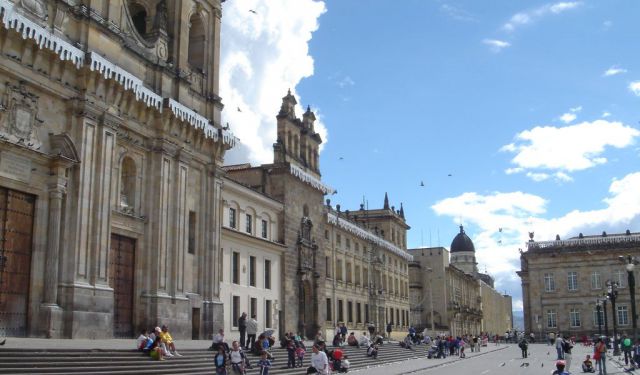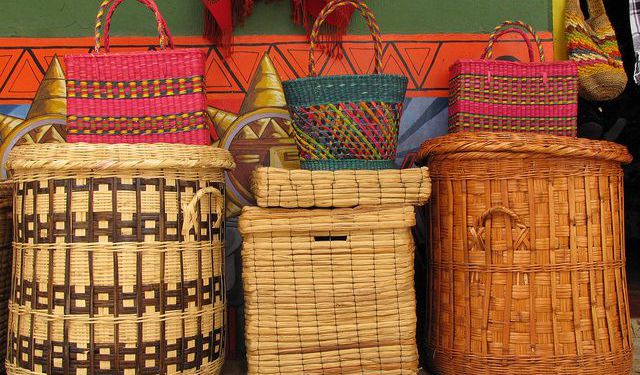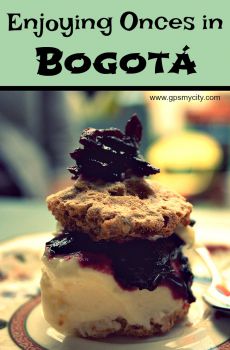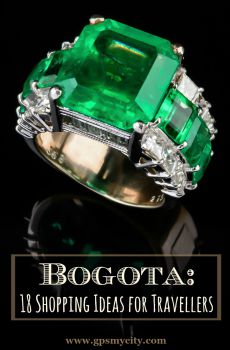
Along the Avenida Jiménez, Bogota, Colombia (A)
Once a river at the boundary of colonial Santa Fe, the Avenida Jiménez would later become the epicenter of the 1948 Bogotazo riots. After an ingenious intervention in the late 1990s, this historic avenue has never looked better. Sights include the Gold Museum, the Quinta Bolívar, colonial churches, architectural gems and high above the Colombian capital - Monserrate. There's a little shopping and ice cream, along the way too.
How it works: The full article is featured in the app "GPSmyCity: Walks in 1K+ Cities" on Apple App Store and Google Play Store. Download the app to your mobile device to read the article offline and create a self-guided walking tour to visit the sights featured in this article. The app's navigation functions guide you from one sight to the next. The app works offline, so no data plan is needed when traveling abroad.
Sights Featured in This Article
Guide Name: Along the Avenida Jiménez
Guide Location: Colombia » Bogota
Guide Type: Self-guided Walking Tour (Article (A))
# of Attractions: 13
Tour Duration: 3.0 Hour(s)
Travel Distance: 5.0 Km or 3.1 Miles
Author: Andrew Dier
Author Bio: Andrew Dier is originally from Northwest Florida and has lived in Bogotá for several years.
Sight(s) Featured in This Guide:
Guide Location: Colombia » Bogota
Guide Type: Self-guided Walking Tour (Article (A))
# of Attractions: 13
Tour Duration: 3.0 Hour(s)
Travel Distance: 5.0 Km or 3.1 Miles
Author: Andrew Dier
Author Bio: Andrew Dier is originally from Northwest Florida and has lived in Bogotá for several years.
Sight(s) Featured in This Guide:
- Museo del Oro
- Iglesia La Tercera
- Iglesia de San Francisco
- Avenida Jiménez
- Palacio de San Francisco
- Edificio Pedro López
- Edificio Henry Faux and the Bogotazo
- Edificio El Tiempo
- Edificio Monserrate
- Hotel Continental
- Las Aguas
- Quinta Bolívar
- Monserrate
1

1) Museo del Oro
Some visitors come to Bogotá specifically to see the Museo del Oro. During your museum experience (avoid Sundays – free day; on Mondays it's closed), you will see just a fraction of the thousands of items, now property of the Banco de la República, Colombia’s central bank, since their first acquisition in 1939. The museum tells the story of how – and why - the native peoples of Colombia created the incredibly detailed and surprisingly modern designs of gold jewelry and religious objects. One of the highlights is the golden raft produced by Muisca Indians. The raft portrays the ritual of El Dorado, “the golden one.” When a tribal leader was chosen, he was covered in gold dust and rowed out to the center of the Guatavita lagoon, high in the mountains, about an hour away from the city. Once there, he would toss gold and emerald offerings overboard to their god below in the waters. To the Spanish conquistadors, El Dorado soon became synonymous with the area, a place of golden riches beyond their wildest dreams. Another piece to look for is that first acquisition, the Quimbaya Poporo. Poporos were used during religious ceremonies which involved the chewing of coca leaves. Finally is the unforgettable offering room, filled with golden treasures. English explanations are surprisingly good throughout the museum (so is the audio tour), and the restaurant serves up Colombian and Italian fare, often packed at lunchtime – a good sign.
2

2) Iglesia La Tercera
This small church is one of the jewels of colonial churches in Bogotá. It was built adjacent to San Francisco in the late 18th century, about fifty years before Colombian independence. Architecturally the main highlight is its barrel vaulted ceiling decorated with geometric designs and altarpieces made of cedar and walnut. The woodworker Pedro Caballero was charged with the ornamentation of the church. He reportedly far underestimated the cost of the work and ended up having to pay for much of it out of his own pocket. This drove him to ruin… and to insanity! The third church here in the complex, and the one shown in the photo, is the Vera Cruz. It is where several independence figures, executed by the Spanish, were laid to rest.
3

3) Iglesia de San Francisco
The Iglesia de San Francisco is the oldest of all the churches in the city, built in 1557. When it was built by the Franciscans, it faced a river – which was then renamed the Río San Francisco. It is now the Avenida Jiménez. Note the mudejar style ceiling and of course the fantastic golden altar. There is also a chapel devoted to Saint Francis of Assisi. The church is often full of working-class faithful. Roman Catholicism was the official religion of the country until the new constitution was adopted in 1991. Around 90% of Colombians identify themselves as Catholic.
4

4) Avenida Jiménez
During the colonial era, the Río San Francisco flowed down from the Monserrate mountain through what is today’s Avenida Jiménez. This was the major water source for Santa Fe. It was also the outer limits of the town for many years. In fact, on one bridge over the Calle Real (the Séptima) and where the Jiménez is today, stood an Arco de Triunfo, welcoming dignitaries into Santa Fe. When the river was channeled elsewhere in the mid-20th century, the avenue was created. The Jiménez is adorned by many buildings of architectural interest, from the Republican period (1880s – 1930s) and the modernist era (1940s – 1960s), but perhaps the most remarkable addition to the avenue is also its most modern intervention. In the late 1990s during the mayorship of Enrique Peñalosa, in addition to the construction of a TransMilenio line, the avenue was converted into Bogota’s biggest pedestrian zone. Acclaimed Bogotá architect Rogelio Salmona designed the “Eje Ambiental” one of the most innovative urban projects the city has ever seen. Framed by the Monserrate and Guadalupe mountains, red brick walkways and pools of water extend from the Las Aguas church to the Avenida 10, a re-creation of the old river. The Jiménez is named for Bogota’s founder, Gonzalo Jiménez de Quesada, a Spaniard of Jewish ancestry who founded Santa Fe in 1538 after conquering local Muisca Indians.
5

5) Palacio de San Francisco
Next to the church is the neoclassical Palacio de San Francisco, designed in 1917 by the French architect Gastón Lelarge. He also designed the City Hall and the Casa de Nariño in the historic center. After razing the convent of the church (they were going to tear the church down as well), this served as the governor's offices of the Cundinamarca department. Note the statues depicting peace and work above the main façade. There is talk that the building may eventually be converted into a museum of fine arts. Now walk further down the avenue. Notable modern and international style buildings on your right (north side) of the Jiménez include: the Edificio Caja Colombiano de Ahorros, from 1948; the Mies van der Rohe-inspired Edificio Camacho, also from 1948; and finally at Carrera 10, the international style Banco de Bogotá building. It was built in 1960 with consultants from the firm who built the Lever Building in Manhattan. The Banco de Bogotá is the oldest bank in Colombia, founded in 1871. A TransMilenio line opening in 2011 on Carrera 10 should make this area much more organized. Near the Decima, street vendors and homeless people abound; smile and relax - but watch your stuff!
6

6) Edificio Pedro López
Returning towards the mountains on the right side, look for the Edificio Cubillos from the 1920s and, directly across from the Palacio de San Francisco, the Edificio Pedro López, now home to the Ministry of Agriculture. When it was built, some complained of its “cold style… typical of American skyscrapers.” Sure enough, the building was constructed by the same American brothers who would later build the Chrysler Building in New York City – the world’s tallest building in 1930. As you return to the Séptima, you will no doubt see dozens of men milling about, wheeling and dealing. They are trading emeralds. Colombia is the world’s emerald capital. The largest emerald mines are located in the department of Boyacá, to the north of the city.
(Source: Guías Elarqa De Arquitectura, Bogotá Centro Histórico, 2005)
(Source: Guías Elarqa De Arquitectura, Bogotá Centro Histórico, 2005)
7

7) Edificio Henry Faux and the Bogotazo
It was here in front of the Henry Faux building (a.k.a. where McDonald's is) that on April 9th, 1948 populist Liberal Party presidential candidate Jorge Eliécer Gaitán was assassinated. The “Crime of the Century” resulted in mass rioting, which would later be called the “Bogotazo.” In his acclaimed book “The Making of Modern Colombia,” historian David Bushnell says that, while Bogotá was the most affected by violence, it would be more accurate to call these events “El nueve de abril” as deadly fighting erupted across the country. Just how savage was the violence of that day? Bushnell retells an account from a town near Cali, where enraged Liberals decapitated Conservatives, playing soccer with their heads! Colombian Nobel Prize winner Gabriel García Márquez lived at the time in a pension attached to the Palacio San Francisco. According to an essay by him, with the building in flames what was his first thought: his typewriter! He and his brother rushed back to retrieve it, not fully grasping the implications this day would have on Colombia. After the ten hour melee, up to five thousand people had been killed, women raped, stores ransacked and dozens of buildings burned. Thus began the dark years of “La Violencia,” which would claim the lives of 200,000 Colombians during the 1950s, as Liberals and Conservatives fought each other in cities, towns and villages throughout the country.
(Sources: The Making of Modern Colombia, 1993; Guía Literaria de Bogotá, 2007)
(Sources: The Making of Modern Colombia, 1993; Guía Literaria de Bogotá, 2007)
8
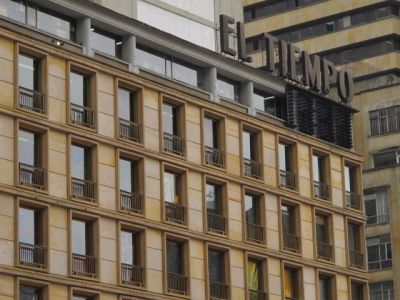
8) Edificio El Tiempo
Crossing the Séptima, look down and notice the old street car tracks. These are remnants of the old trolley system that originally used mules when it first began service in 1884. It was later run by the American Bogotá City Railway Company. Bogotanos, dressed in dark clothing, fitting with the oft gloomy weather, took the tranvía from downtown to Chapinero until 1951. It never recovered from damages sustained during the Bogotazo. On your right stands the El Tiempo building. Founded in 1911 El Tiempo is Colombia’s most important daily newspaper (their headquarters are now on the Avenida El Dorado). The powerful Santos family (Juan Manuel Santos was elected president in 2010) were majority shareholders since nearly its beginning until the Planeta publishers from Spain recently bought control. Look for the old San Francisco bowling alley downstairs. It’s tiny, only six lanes, and the pins are set up manually. It claims to be Latin America’s oldest, opened in the 1940s. On the opposite side of the Jiménez is the Banco de la República building.
9

9) Edificio Monserrate
For many, the Edificio Monserrate is their favorite building on the Jiménez. It was built in the late 1940s and is famous for having been the headquarters of the El Espectador newspaper – Colombia’s oldest national paper. El Espectador was a leading Liberal voice in the country and their headquarters (along with the El Tiempo building) was ransacked by Conservative sympathizers in the turbulent 1950s. Also around that time García Márquez published his first short story in the paper. In the mid-1980s the director, Guillermo Cano, a descendent of the founder, boldly took on drug traffickers and corruption. He was murdered in 1986 by one of Pablo Escobar’s subordinates near the paper’s new headquarters on the Avenida El Dorado. Three years later the building was bombed by the Medellín cartel. In honor of his courage, UNESCO named its World Press Freedom Prize for Cano. Today the main shareholder is Julio Mario Santo Domingo, one of the richest men in Colombia. If you are ready for a crêpe… or waffle, visit, you guessed it, the chain Crepes & Waffles in the building basement. The food is quite good (desserts particularly yummy) and the restaurant has a policy of hiring women heads of households. A few years back passerby were baffled to see thousands of plantains filling one entire floor of the building. The installation by Mexican artist Héctor Zamora lasted for about a month, and when the plantains turned yellow and ripe, they were donated to local food banks.
10

10) Hotel Continental
The fabulous Hotel Continental building has, after years of decay and speculation of its imminent razing, been spruced up, and converted into apartments. There’s a small – yet swanky - nightclub on the other side of the building. The hotel was built as Bogotá prepared to host the 9th Panamerican Conference in 1948. During conference proceedings, the Organization of American States was created. Unfortunately, and with dignitaries from across the hemisphere on hand including U.S. Secretary of State George C. Marshall, Gaitán was assassinated, provoking widespread pandemonium. Fueling communist conspiracy theories, the young Fidel Castro also happened to be in town, at a student conference. Walking up towards the mountains, on the left is the Parque de los Periodistas, named because journalists would mingle there. The focal point is a pavilion, designed by Italian Pietro Tenerani. He also made the statue of Bolívar that stands in the Plaza de Bolívar. The pavilion was dedicated in commemoration of the Liberator’s 100th birthday, and has been moved about several times in Bogotá. The original statue of Bolívar remains in the city of Tunja.
11

11) Las Aguas
At the end of the Eje Ambiental is the blinding white, 17th century Las Aguas church. It’s only open for mass, but the main attraction here just might be shopping. Artesanías de Colombia has a shop to the right of the church showcasing high-quality Colombian handicrafts from across the country. But they don’t just sell beautiful wares. The organization also provides technical training to artisans and works with displaced persons and indigenous and afro-colombian groups. You’ll exit in the back, and at the heart of the Universidad de Los Andes. This is probably the most prestigious university in the country. Bogotá is home to over 450,000 higher education students and this part of town is where several are located, including the Externado, Rosario, Jorge Tadeo and further uptown, the Javeriana. The schools often have interesting cultural programs, and many of them also offer Spanish instruction for foreigners.
12

12) Quinta Bolívar
As you can tell this is one of Bogota’s most dynamic parts of town. As you walk towards the country house of Bolívar, if you look back towards the city, you might see construction happening on the massive new Spanish Cultural Center. But back in time to the 1820s: the Quinta de Bolívar was acquired by the then vice president of Gran Colombia, Francisco de Paula Santander, and presented in appreciation to the country’s first president, Simón Bolívar and his companion Manuela Sáenz . Bolívar didn’t really spend much time there, as he was busy defeating the Spanish in Peru and Bolivia and ruling several new countries simultaneously. After assuming dictatorial powers in 1828, things went downhill from there. He would die two years later in Santa Marta, as he was preparing for exile to France. The quinta, surrounded by a lovely garden, has a small museum and it’s a nice place to spend some time. Hard to believe that this was once the Bogotá countryside.
13

13) Monserrate
The tour ends at the top, specifically 10,341 feet “closer to the stars,” high above this Andean metropolis. To reach it, you can take the funicular railway, the cable car or, if you’re up for it, go by foot. Climbing is popular – and safer - on Sundays and holidays. The first chapel was built on the top of the mountain in the late 17th century, in honor of the “black virgin” of Monserrat near Barcelona. The faithful pray to the Fallen Christ, a sculpture from the 17th century in the church. The church itself is not considered anything special architecturally speaking. The view, however, is spectacular, perhaps more so as night falls. The restaurants atop are popular with locals who are showing visiting “Gringos” the town. It’s also the top marriage proposal location in all of Bogotá. You should reserve in advance. Across the way from the Cerro Monserrate is the Cerro Guadalupe, which can be visited as well, although not as easily. Monserrate is open daily until midnight. On Sundays it closes at 6 p.m.
Walking Tours in Bogota, Colombia
Create Your Own Walk in Bogota
Creating your own self-guided walk in Bogota is easy and fun. Choose the city attractions that you want to see and a walk route map will be created just for you. You can even set your hotel as the start point of the walk.
Architectural Jewels
Bogota, Colombia, is quite a city for an architectural experience. Attentive to the local historical heritage, the city has managed to preserve in full splendor most of its colonial buildings.
One such gem is the Palace (or House) of Nariño, the official residence of the President of Colombia. Its grandeur and historical significance make it a prominent landmark.
Not far away from it... view more
Tour Duration: 2 Hour(s)
Travel Distance: 3.7 Km or 2.3 Miles
One such gem is the Palace (or House) of Nariño, the official residence of the President of Colombia. Its grandeur and historical significance make it a prominent landmark.
Not far away from it... view more
Tour Duration: 2 Hour(s)
Travel Distance: 3.7 Km or 2.3 Miles
Bogota Shopping Tour
Colombia is known for its gold and emeralds, recognizable national clothing, pottery, accessories, and other crafts. The country's capital Bogota is so rich in authentic shopping that it's almost mind-boggling to decide what to buy first and most importantly, where to buy it at the best possible price!
Start your quest at Pasaje Rivas Market, Bogota's oldest marketplace, offering... view more
Tour Duration: 1 Hour(s)
Travel Distance: 2.3 Km or 1.4 Miles
Start your quest at Pasaje Rivas Market, Bogota's oldest marketplace, offering... view more
Tour Duration: 1 Hour(s)
Travel Distance: 2.3 Km or 1.4 Miles
Bogota Old Town Walking Tour
In 1538, the indigenous Muisca of the Colombian Altiplano had the advantage in numbers over the force of conquistador Gonzalo Jimenez de Quesada. Arriving in the Muisca Federation, the Spanish had only 162 exhausted men. However, the guecha warriors of Chief Tisquesusa were no match. The Federation fell in bloody battle.
In the area now known as Quevedo's Fountain Square, Quesada set up 12... view more
Tour Duration: 2 Hour(s)
Travel Distance: 4.1 Km or 2.5 Miles
In the area now known as Quevedo's Fountain Square, Quesada set up 12... view more
Tour Duration: 2 Hour(s)
Travel Distance: 4.1 Km or 2.5 Miles
Useful Travel Guides for Planning Your Trip
Enjoying Onces in Bogota
Elevenses, on the surface, seem to be a particularly British tradition, a break for something light and sweet between breakfast and lunch, a time to gossip, a time to catch up, a time just to be. Lo and behold, Colombia somewhere along the line adapted this tradition in a particularly Latin fashion....
18 Uniquely Columbian Things to Buy in Bogota
To those who understand Russian, the word "Bogota" sounds very similar to the one translating as "rich". And, indeed, the city does live up to this name connotation in terms of peculiar things worth exploring in addition to coca, coffee and emeralds. Here's the longer list...
The Most Popular Cities
/ view all

